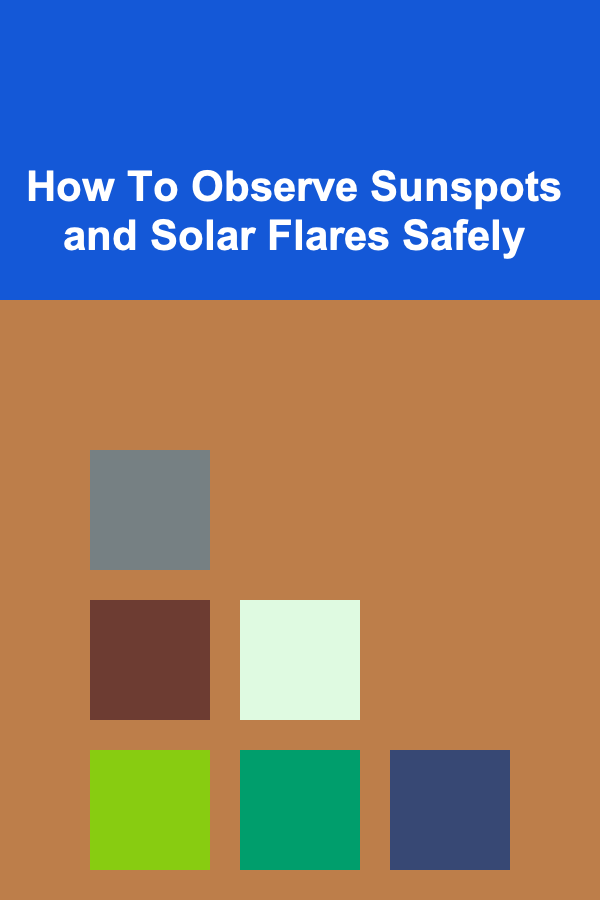
How To Observe Sunspots and Solar Flares Safely
ebook include PDF & Audio bundle (Micro Guide)
$12.99$6.99
Limited Time Offer! Order within the next:

The Sun, our closest star, is a fascinating object to observe. From its seemingly constant glow to the phenomena that occur on its surface, such as sunspots and solar flares, there is much to explore and learn. However, despite being an essential part of our daily lives, the Sun's powerful radiation can be dangerous. Observing sunspots and solar flares can be an exciting and rewarding experience, but it's crucial to do so safely to avoid harm. In this article, we will guide you through the process of safely observing these solar phenomena while understanding their science, importance, and how to use the right equipment to ensure your safety.
What Are Sunspots and Solar Flares?
Before diving into the specifics of safely observing sunspots and solar flares, it's important to understand what they are.
Sunspots
Sunspots are temporary, dark areas on the Sun's surface caused by magnetic activity. These spots are cooler than the surrounding areas and appear darker due to the fact that they are about 1,500--2,000 degrees Celsius cooler than the Sun's outer atmosphere. Sunspots usually appear in groups and are a manifestation of the Sun's magnetic field, which can cause disturbances in solar radiation.
Sunspot activity follows an 11-year solar cycle, with periods of high activity called the "solar maximum," when sunspots are more frequent, and the "solar minimum," when they are less visible. The number and size of sunspots can be used to predict space weather and the potential for solar storms, which can impact Earth's magnetic field.
Solar Flares
Solar flares are sudden bursts of energy and radiation from the Sun's surface, often occurring near sunspots. They are intense releases of electromagnetic radiation that can affect radio communications, GPS systems, and even power grids on Earth. Solar flares are classified according to their strength, with X-class flares being the most intense. These events can release vast amounts of energy in the form of light, heat, and energetic particles.
Solar flares can also be associated with coronal mass ejections (CMEs), which are massive eruptions of solar wind and magnetic fields that can impact Earth's magnetosphere and cause geomagnetic storms. While solar flares are not directly harmful to humans on Earth, the disruptions they cause in space weather can have serious consequences for technology and communication systems.
Why is Observing the Sun Important?
Observing the Sun is essential for understanding the dynamic processes that occur in our solar system. By studying sunspots and solar flares, scientists can:
- Monitor Space Weather: The Sun's activity affects the Earth's space environment. By tracking sunspots and flares, we can predict solar storms and take measures to protect satellites, power grids, and other technology from space weather disruptions.
- Understand the Sun's Behavior: The Sun is the primary source of energy for life on Earth. By observing it, scientists can better understand its cycles, its influence on the climate, and how it will behave in the future.
- Predict Solar Activity: Solar activity follows a cycle. Studying sunspots and flares helps scientists predict when activity will peak and when the Sun will be relatively calm. This information is crucial for preparing for potential space weather events.
However, while observing the Sun can be incredibly rewarding, safety is paramount. The Sun's radiation is extremely powerful, and looking directly at it without proper protection can cause permanent eye damage, including blindness. Therefore, understanding how to observe these phenomena safely is crucial.
Safety Precautions for Observing the Sun
When observing the Sun, it is important to use proper safety measures to protect your eyes and body from the harmful effects of solar radiation. Here's what you need to know:
1. Never Look Directly at the Sun Without Protection
Looking directly at the Sun without proper protection can cause solar retinopathy, a condition that results in permanent damage to the retina. The intense sunlight can burn the sensitive tissues in your eyes, and this damage is often painless but irreversible. Even during an eclipse or when there are sunspots visible, never attempt to look directly at the Sun without proper eye protection.
2. Use Solar Viewing Glasses or Filters
The best way to observe the Sun safely is to use solar viewing glasses or solar filters . These specialized glasses and filters block out harmful UV and infrared radiation, allowing you to safely look at the Sun. Make sure the glasses meet the ISO 12312-2 international safety standard for direct solar viewing. Never use regular sunglasses, as they do not offer adequate protection from the Sun's radiation.
When using solar filters with telescopes or binoculars, ensure that the filters are securely attached to the front of the instrument, and never look through the optical equipment without a filter. Observing the Sun through binoculars or telescopes without a proper filter can cause serious eye damage even if the Sun's disk is not directly visible.
3. Use Proper Equipment for Viewing Sunspots
To observe sunspots, you can use special solar telescopes, which are equipped with filters that block out harmful radiation. These telescopes are specifically designed to provide safe, high-quality views of the Sun's surface, including sunspots. Some solar telescopes use Hydrogen Alpha (H-alpha) filters, which allow you to view specific wavelengths of light emitted by the Sun and can reveal sunspots in great detail.
For beginners, it may be easier to purchase a solar telescope that is already equipped with a proper solar filter, as these instruments are designed to be safe and easy to use. Alternatively, you can also attach solar filters to standard telescopes, but you must ensure they are of high quality and are designed specifically for solar observation.
4. Observe Indirectly Using Projection Techniques
An alternative method for observing sunspots safely is through indirect projection techniques. This involves projecting the image of the Sun onto a white surface using a telescope or binoculars. This method is safe because you're not looking directly at the Sun but instead observing its image.
One common method is to use a solar projection screen or solar projection card that fits on the eyepiece of your telescope. The image of the Sun will be projected onto the card, where you can view it without any risk to your eyes. However, be cautious and avoid looking at the projection directly through the telescope's eyepiece.
5. Avoid Viewing the Sun Through Regular Glasses, CDs, or Tinted Film
Many people think that using everyday items like sunglasses, CDs, or even tinted film will protect their eyes when observing the Sun, but this is a serious mistake. These items do not provide adequate protection from harmful solar radiation, and they can still allow intense sunlight to enter your eyes, potentially causing irreparable damage.
6. Watch Solar Flares with Specialized Instruments
While solar flares are not typically visible to the naked eye, they can be studied indirectly through instruments designed to detect their effects. Radiotelescopes can measure the radio emissions from solar flares, and X-ray telescopes can detect high-energy radiation from these bursts. You can also track solar flares through space weather stations or online resources provided by institutions like NASA.
For personal observation, watching the aftermath of solar flares through auroras (the Northern and Southern Lights) is a safer alternative. These atmospheric phenomena are caused by the interaction between the Sun's charged particles and Earth's magnetic field. Solar flare activity often leads to more intense auroras, making them a spectacular and safe way to observe solar activity.
Additional Tips for Safe Solar Observation
- Check the Weather and Solar Activity: Before heading outside to observe the Sun, make sure the weather is clear, and solar activity is at an interesting level. You can check solar activity predictions on websites like NASA's Space Weather Prediction Center or NOAA's Space Weather Prediction Center.
- Don't Use Home-Made Filters: Homemade filters or improvised methods are not safe. Stick to certified solar glasses or filters specifically designed for solar observation.
- Supervise Children: If you're observing the Sun with children, make sure they have the proper protection and understand the risks of looking directly at the Sun.
- Take Breaks: Staring at the Sun through a telescope or viewing glasses for prolonged periods can cause eye fatigue. Take regular breaks to avoid strain.
Conclusion
Observing sunspots and solar flares can be a thrilling experience, but it must always be done with caution and care. The Sun's radiation is incredibly powerful, and improper viewing can lead to permanent eye damage. By using the proper equipment, such as solar glasses or telescopes with solar filters, and following the safety guidelines outlined above, you can enjoy the beauty and scientific importance of the Sun without compromising your health.
Whether you're observing sunspots during the solar maximum or trying to catch a glimpse of a solar flare, make sure you do so safely and responsibly. Understanding the dynamics of the Sun can give you a greater appreciation for our solar system, and with the right tools, you can safely enjoy these incredible solar phenomena.

How to Create Engaging Pet Content to Attract Customers
Read More
How to Market Your Home Rental Property During Slow Seasons
Read More
How to Use Vacuum-Sealed Bags for Fabric Storage
Read More
How To Live a Life Without Regret
Read More
How to Budget for Travel
Read More
Exploring the Myths of the Ancient Near East
Read MoreOther Products

How to Create Engaging Pet Content to Attract Customers
Read More
How to Market Your Home Rental Property During Slow Seasons
Read More
How to Use Vacuum-Sealed Bags for Fabric Storage
Read More
How To Live a Life Without Regret
Read More
How to Budget for Travel
Read More